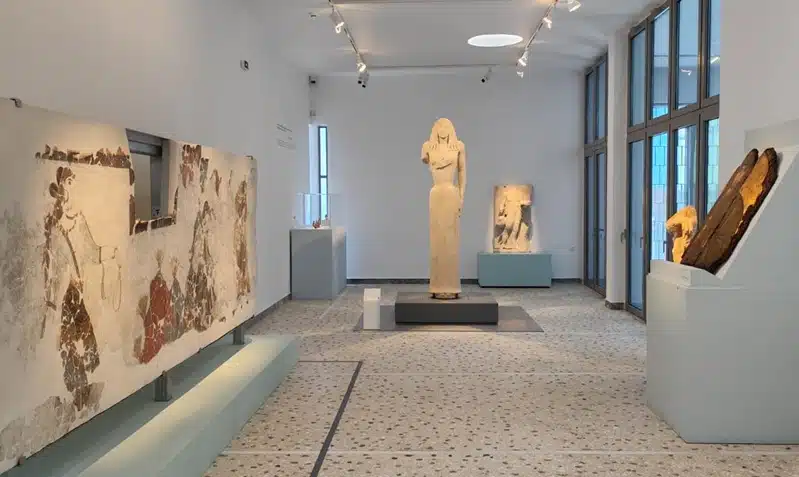The “Kore of Thera” was a prominent exhibit in the highly successful “Cycladic Women: Unknown Stories of Women of the Cyclades” exhibition. This unique exhibition explores the history of the Cyclades through a female lens, illuminating the evolving role of women in island societies from prehistory to post-Byzantine times.
The Archaeological Museum of Thera has officially reopened, inaugurated by Minister of Culture Lina Mendoni. This extensive renovation delivers a new cultural landmark to Santorini, boasting modern museum standards for both locals and the island’s thousands of visitors.
The Archaeological Museum of Thera’s renovation project was integrated into the Ministry’s “Cultural Development and Daily Life Charter,” a national initiative designed for each region of Greece.
The museum’s reopening coincides with the summer tourist season, adding another valuable cultural asset alongside the prehistoric settlement of Akrotiri, the Museum of Prehistoric Thera, and Ancient Thera.
The museum building, originally designed by architect Konstantinos Dekavallas after the devastating 1956 earthquake, incorporates elements of the modern movement, including skylights and strategic views. Over time, the building required extensive renovation to address aging infrastructure and the demands of increased visitors.
The Ephorate of Antiquities of the Cyclades undertook the meticulous restoration, revitalizing the original architectural design while upgrading all systems, including energy efficiency and security.
The centerpiece of the renovated museum is the Kore of Thera, a commanding 2.48-meter-high Archaic statue carved from Naxian marble. Discovered in 2000 in Sellada, the necropolis of Ancient Thera, this significant and nearly intact find remained out of public view for 22 years until its temporary display in the museum’s renovation phase in late 2022.
Now, the Kore is proudly displayed in her permanent home, secured by an anti-seismic base. This base, designed by the National Technical University of Athens’ static engineering laboratory and applied by the Ephorate of Antiquities of the Cyclades at the Acropolis Museum’s Conservation Laboratory, ensures the statue stands freely and safely, highlighting its archaic beauty.
Through personal narratives and lesser-known aspects of the female experience, it delves into themes of identity, equality, participation, and autonomy. It showcases how Cycladic women, at times constrained by societal norms, also played dynamic roles in family, religion, economy, and politics, connecting past and present by inviting reflection on women’s enduring journey as carriers of both tradition and change.
This partnership, which began in May 2024, aims to unlock new avenues for researching, studying, and promoting Cycladic culture globally. Key initiatives include the creation of the first digital “Corpus” of all Early Cycladic marble figurines and vases found in museums and private collections worldwide.
“The fruit of this collaboration is the exhibition ‘Cycladic Women’,” Marinopoulou stated. “From the planning stages, we, along with Minister Mendoni and Ephorate Director Dimitris Athanasoulis, decided that ‘Cycladic Women’ should continue its journey to Santorini to inaugurate the renovated Archaeological Museum of Thera. Our decision was another way to give back to the Cyclades, as they are the very reason for our museum’s existence.”
Greek Reporter, Tasos Kokkinidis
ΟΔΥΣΣΕΙΑ, 23/6/2025 #ODUSSEIA #ODYSSEIA, Magdalene Duca Montesantou

